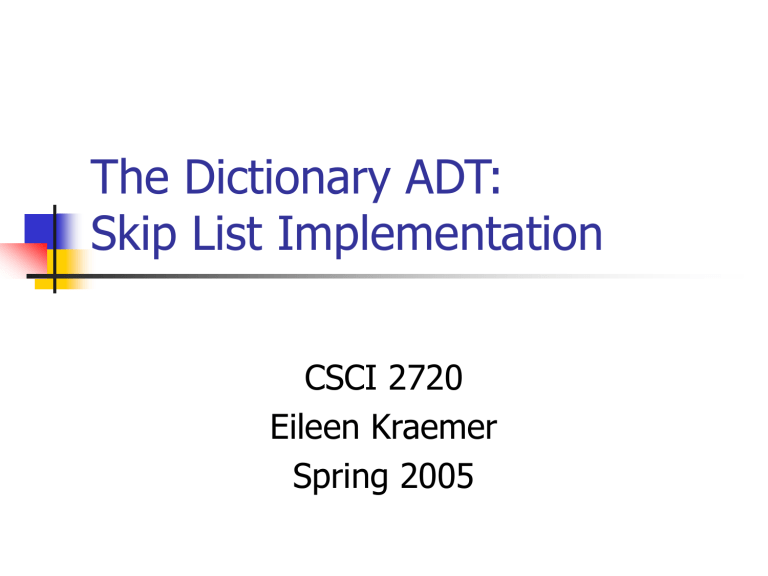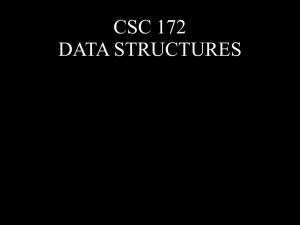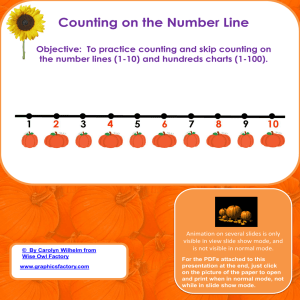Skip Lists

The Dictionary ADT:
Skip List Implementation
CSCI 2720
Eileen Kraemer
Spring 2005
Definition of Dictionary
Primary use: to store elements so that they can be located quickly using keys
Motivation: each element in a dictionary typically stores additional useful information beside its search key. (eg: bank accounts)
Can be implemented using lists, binary search trees, Red/black trees, hash table, AVL tree, Skip lists
Dictionary ADT
Size(): Returns the number of items in D
IsEmpty(): Tests whether D is empty
FindElement(k): If D contains an item with a key equal to k, then it return the element of such an item
FindAllElements(k): Returns an enumeration of all the elements in D with key equal k
InsertItem(k, e): Inserts an item with element e and key k into D.
remove(k): Removes from D the items with keys equal to k, and returns an numeration of their elements
Performance considerations: lists
Size():
O(1) if size is stored explicitly, else O(n)
IsEmpty():
O(1)
FindElement(k):
O(n)
… and we’ll talk about variations lists that can improve this
InsertItem(k, e):
O(1) (assumes item already found)
Remove(k):
O(1) (assumes item already found)
Pros and cons: list and array implementations
Lists:
Efficient insertions/deletions -- O(1)
Inefficient searching – O(n)
Optimizations exist, but still ….
Arrays:
Efficient lookup/searching
On index O(1)
On key values (using Binary Search) -- O(log n)
Inefficient insertions/deletions -- O(n)
Skip List: characteristics of both lists and arrays
A list on which we can perform binary search
Skip Lists support O(log n)
Insertion
Deletion
Querying
A relatively recent data structure
“A probabilistic alternative to balanced trees”
(Perfect) Skip Lists
A skip list is a collection of lists at different levels
The lowest level (0) is a sorted, singly linked list of all nodes
The first level (1) links alternate nodes
The second level (2) links every fourth node
In general, level i links every 2 i th node
In total, log
2 n levels (i.e. O(log
2 n) levels).
Each level has half the nodes of the one below it
Example of a (perfect)Skip List
S
3
S
2
S
1
S
0
-
-
-
-
12
23
23 26
31
31
31 34
44
44 56
64
64
+
+
+
+
Insertions/Deletions
When we add a new node, our beautifully precise structure might become invalid.
We may have to change the level of every node
One (sneaky) option is to move all the elements around
Both options take O(n) time, which is back where we began
Is it possible to achieve a net gain?
Example of a randomized
Skip List
S
3
S
2
S
1
S
0
-
-
-
-
12
23
23 26
31
31
31
34
34 44 56
64
64 78
+
+
+
+
Definition of Skip List
A skip list for a set
S S
S such that: of distinct (key, element) items is a series of lists S
0
,
1
, … ,
Each list
List S order
0
S h i contains the special keys contains the keys of S
+ and - in nondecreasing
Each list is a subsequence of the previous one, i.e.,
List S h
S
0
S
1
… S h contains only the two special keys
Initialization
A new list is initialized as follows:
1) A node NIL ( + ) is created and its key is set to a value greater than the greatest key that could possibly used in the list
2) Another node NIL ( - ) is created, value set to lowest key that could be used
3) The level (high) of a new list is 1
4) All forward pointers of the header point to
NIL
Searching in Skip List
We search for a key x in a skip list as follows:
We start at the first position of the top list
At the current position p , we compare x with y key ( after ( p ))
x = y : we return element ( after ( p )) x > y : we “scan forward” x < y : we “drop down”
If we try to drop down past the bottom list, we return NO_SUCH_KEY
Example: search for 78
S
3
-
S
2
-
Searching in Skip List Example
31
+
+
S
1 -
23 31 34 64
+
S
0
-
12 23 26 31 34 44 56 64 78
+
1) P is
64, at S
1
,
+ is bigger than 78, we drop down
• At S
0
, 78 = 78, we reach our solution
Insertion
The insertion algorithm for skip lists uses randomization to decide how many references to the new item (k,e) should be added to the skip list
We then insert (k,e) in this bottom-level list immediately after position p. After inserting the new item at this level we “flip a coin”.
If the flip comes up tails, then we stop right there. If the flip comes up heads, we move to next higher level and insert (k,e) in this level at the appropriate position.
Randomized Algorithms
A randomized algorithm performs coin tosses (i.e., uses random bits) to control its execution
It contains statements of the type b random () if b = 0 do A …
else { b = 1} do B …
Its running time depends on the outcomes of the coin tosses
We analyze the expected running time of a randomized algorithm under the following assumptions
the coins are unbiased, and
the coin tosses are independent
The worst-case running time of a randomized algorithm is large but has very low probability (e.g., it occurs when all the coin tosses give “heads”)
Insertion in Skip List Example
1) Suppose we want to insert 15
2) Do a search, and find the spot between 10 and 23
3) Suppose the coin come up “head” three times
S
2
S
1
S
0 p
2
- p
1
-
-
10 p
0
23
23 36
+
+
+
S
3
-
S
2
-
S
1
-
S
0
-
10
15
15
15
23
23 36
+
+
+
+
Deletion
We begin by performing a search for the given key k. If a position p with key k is not found, then we return the NO SUCH KEY element.
Otherwise, if a position p with key k is found
(it would be found on the bottom level), then we remove all the position above p
If more than one upper level is empty, remove it.
Deletion in Skip List Example
S
3
-
S
2
-
S
1
-
S
0
-
1) Suppose we want to delete 34
2) Do a search, find the spot between
23 and 45
12
3) Remove all the position above p
+ p
2
34
+
S
2
- p
1
23 34
+
S
1
-
23 p
0
23 34 45
+
S
0
-
12 23 45
+
+
+
Randomized Skip Lists
We sacrifice “perfection” in order to improve our performance of
Insert/Remove.
So our array of lists is no longer going to be that of exact traversals of successive mid-points but it’s going to be approximately so.
We choose the height of a new node randomly. We want the proportion of number of level-0 nodes, level-1 nodes,
Randomized Skip Lists
In Randomized Skip Lists, when we Insert a new node we no longer shift values but instead we insert the node and simply generate a “random” level for it.
This works well when we have a large number of nodes which gives a fairly uniform mix of node levels.
Not perfect but we can still skip over large groups of nodes
Generating Random Heights
Consider this pseudo-code snippet
(assume n is the no. of nodes)
NodeLevel = 0; x = rand( ); while( x < 0.5 && NodeLevel < log
2
{ NodeLevel++; x = rand( );
} n )
This generates a good mix if rand( ) works correctly
Analysis (Randomized)
Expected height of a node:
E[h] = 0.5 * 0 + 0.5 * (1 + E[h])
Very high probability that maximum height is O(log n)
Probability h > 2 log n = 1/n
Probability h > c log n = 1/n c-1
Expected number of nodes on level i is n/2 i
Expected time for Find( ), Insert( ),
Remove( ) is O(log n)
Analysis of Find( )
Consider traversing the list backwards
Assume the list has up and left pointers
Algorithm p = CurrentNode level 0 pointer while (p != Head) if up(p) exists p = up(p) else p = left(p)
Analysis of Find( )
Probability that up(p) exists is 0.5
Therefore, we expect to take each branch of the loop an equal number of times
So the total number of moves is 2 * the number of upward moves
But the height is only O(log n)
So, the total number of moves is O(log n)




